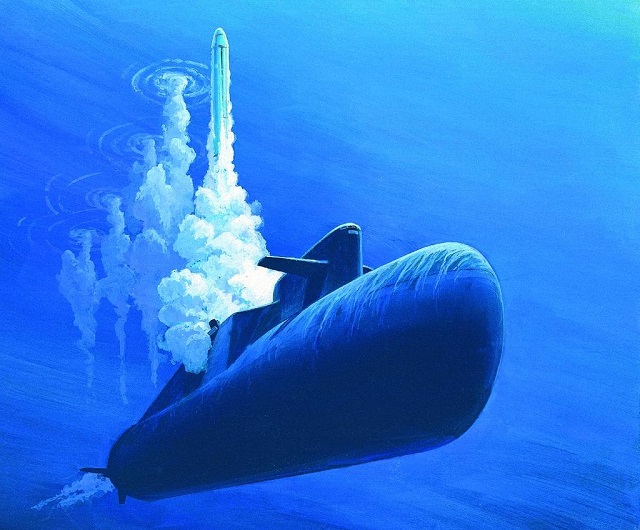 Illustration:
A Soviet DELTA III nuclear powered ballistic missile submarine firing
SS-N-18 missiles Illustration:
A Soviet DELTA III nuclear powered ballistic missile submarine firing
SS-N-18 missiles |
|||
Makeyev Director
General/General Designer Vladimir Degtyar said the company was executing
several Defense Ministry-placed orders for developing land-based and
sea-launched ballistic missiles - the Sarmat advanced heavy ICBM designed
to update the land-based ICBM fleet and another sophisticated missile. Makeyev’s director general declined to comment in greater detail. According to the military industrial commission, he may have meant an advanced SLBM designed to replace the Bulava (NATO reporting name: SS-N-32) cutting-edge strategic missile from the Moscow Institute of Thermal Engineering. The missile is in development for the Project 955 Borei-class (Dolgorukiy-class) fourth-generation nuclear-powered ballistic missile submarines (SSBN). The lead ship of the series, the Yuri Dolgorukiy, was commissioned by the Russian Navy in January 2013. In all, the Navy will take delivery eight Borei-class SSBNs for service with the Northern and Pacific fleets. According to Rubin Central Design Bureau Director General Igor Vilnit, however, the designing of fifth-generation nuclear-powered attack submarines and SSBNs has kicked off. They will feature multilayer composite materials, according to Valery Polovinkin, advisor to director general of the Krylov State Research Center. Composites will be used in the hull coating, bow and stern planes, stabilizers, fairwater and even screws and shafting. This will reduce noise. However, the key feature of the submarine will be its modular design with the commonized bow and stern sections fit for building both SSBNs and attack subs, with only their armament compartments being swapped as needed. The construction of the new-generation boats is planned for 2030 at the earliest. According to Vadim Kozyulin, professor with the Academy of Military Sciences, this will be a response to the upgrade of the US nuclear forces slated for 2020. Washington will spend $900 billion for this purpose. Even now, one can guess what can be expected from the Americans, judging by Russian designers developing missiles able to attack targets in any direction across the North or South Poles and carry hypersonic maneuvering re-entry vehicles penetrating the low-altitude missile defenses by means of unpredictable maneuvering on re-entry. The Sarmat will be able to do exactly this, according to Russian Deputy Defense Minister Yuri Borisov. He said the missile would have a more powerful engine allowing more penetration aids to be carried for it to punch through the US missile defenses. The sophisticated missile will be too tough for the space-based antimissile tier and fit for launching virtually from anywhere in any direction. This implies that the Makeyev-offered development of the SLBM should take into account the growth of future threats by 2030. Given the 19-year-long development of the Bulava SLBM since 1997, the start of developing its successor is long overdue, according to the Izvestia daily. © Copyright 2016 TASS. All rights reserved. This material may not be published, broadcast, rewritten or redistributed. |
|||
Russia ordered the development of a new SLBM submarine-launched ballistic missile
- Posted On










